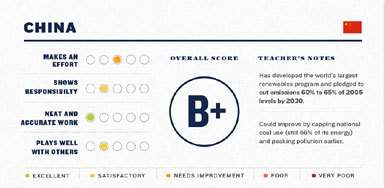During China’s presidential visit to the US this week, news organizations splashed the country’s intention to start a national cap-and-trade program in 2017.
While we’re glad the news media covered it, we’ve been writing about that for years as China has been preparing for the program through pilots in its largest provinces.
The program is impressive, covering key industry sectors such as power plants, iron, steel and other metals, cement, chemicals, building materials and paper-making.
What didn’t get covered is also significant. China remains committed to cutting carbon emissions 60-65% per unit of GDP; cap coal use by 2020, and run on 20% renewable energy (including nuclear) by 2030. The latter is huge – it means installing as much capacity as the US uses to power our country – 800-1000 gigawatts. Another pledge will increase forest "stock" 4.5 billion cubic meters by 2030.
It will also prioritize renewable energy and more efficient fossil fuel power on the grid – a big change from the current practice of putting coal first, which has caused many wind plants to remain idle. Half of all new buildings will be "green" by 2020, and the share of public transport will reach 30% in medium and large cities by then, says China’s President.
China’s climate pledges earn a B+, according to NRDC.
The US-China Climate Change Working Group addresses the full range of topics: fuel economy standards for heavy-duty and other vehicles, smart grids, carbon capture, energy efficiency in buildings and industry, collecting and managing greenhouse gas emissions data, climate change and forests, industrial boilers efficiency and fuel switching, and climate-smart/low-carbon cities, shipping ports and vessels, zero emission vehicles, and climate forcers such as HFCs.
Read our articles, China Installs As Much Solar As Entire US This Year and China Leads World On Wind Additions Again.
Climate Pledges So Far
So far, 146 countries have submitted climate pledges, which together add up to 2.7°C (4.9°F) of warming by 2100, according to Europe’s Climate Action Tracker.
While that’s obviously not enough to meet the 2°C goal (3.5°F), this is the first time we’re below 3°C. "This is a signal that the process can work," Bill Hare of Climate Analytics told Reuters.
Another group, Climate Interactive, calculates it differently and comes to much more pessimistic figures. Pledges add up to 3.5°C (6.3°F), compared with 4.5°C (8.1°F) under business as usual.
The objective of this year’s Climate Summit is to finally come to an agreement. Periodic reviews and new pledges will be built in, encouraging ramping up over time.
What’s important is getting on the path. Once that happens, countries and stakeholders will find it’s easier and cheaper than expected. That’s the history of environmental cleanup, notes Gavin Schmidt at NASA. "By the time people get 10, 15 years of actually trying to do something, that’s going to lead to greater expertise, better technology, more experience, and then people will then say, ‘Oh, you know what? We can commit to do more.’"
See the grades for the US and other major countries on their climate pledges:
